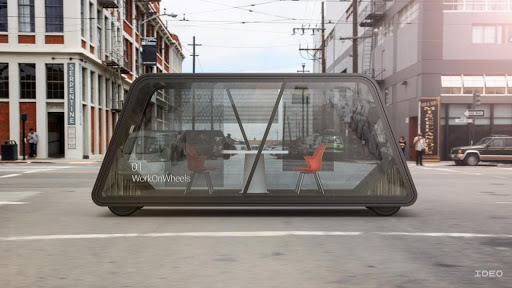Mobile offices, levitating furniture and much more! What will coworking and flexible work-spaces look like in 2030?
2030 might be just a decade away, but our inquisitive minds might still wonder what coworking spaces would look like then. What does flexible workspace have in store for the next decade? Should we be expecting futuristic architectural designs or do we still have a long way to go? While none of us owns a crystal ball to foresee the future, the good news is that we have experts in the industry who can satisfy our curiosity with their predictions.
Work on wheels

Like food on wheels, but work on wheels! in all seriousness, by the year 2030, your office will commute to you! This concept has gone beyond just a mare imagination or a futuristic wish. Work on Wheels is an actual company, and they have been working on this concept for the past few years to ensure that it becomes a reality by the year 2030 or sooner. Work on Wheels will allow coworkers to work while commuting. The innovation will inspire creative thinking, remove the burden on the system of commuting and enable people to work in the city and not around the city, simultaneously increasing employee's happiness and work productivity.
Less set-desk

As technology gets more and more sophisticated, we will see an increase in eccentric technologically driven architectural designs and a dramatic change in the look and feel of coworking spaces. With more coworking spaces offering multi-faceted work environments such as:
Open spaces: The design of open space would help promote social and community interactions, while strengthening relationships between coworkers, which in exchange fuels creativity, and encourages productivity.

Green spaces: This one is somewhat predictable with the world taking the sustainable, holistic and environmentally friendly approach, we will see an increase in workspaces prioritising this element of design to boost productivity and wellbeing in 2030.

Increase in isolated spaces: Although community engagement and events are a large part of coworking, in ten years from now, we can expect an increase in isolated coworking spaces built just for workers who'd prefer to work remotely without the community engagement aspect. This design is ideal for those who work better alone and great news for introverted coworkers.
Robotic colleagues

Okay, this is a no brainer, we have been anticipating for a future where robots will walk amongst us, not much like the Terminator, but robots that will co-operate with humans. These robots will carry out customer service and sales role. They will play a massive role in the future of coworking and by 2030 it would be the norm to see bots roaming about, cleaning, hoovering, delivering packages and acting as secretaries.
Virtual coworking

Technological sophistication and an increase in flexible and remote work will have a further transforming impact on how we work in 2030. We will see an increase in the incorporation of virtual spaces, which is perfect for long-distance meetings and connecting coworkers around the globe. Companies like Sococo, MyWork Hive and Arena are ahead of this prediction. These companies already provide an experience for coworkers to work together without moving from their home desk. Virtual coworking beats isolation, improves productivity and allows you to be a part of a network all in the comfort of your home.
Levitating Furniture

When it comes to furniture trends, we will see an increase in futuristic-looking furniture such as the cloud pads, a unique office or lounge chair that will hover mid-air on comfortable and stylish plexiglass. According to SEC Interiors, future interior designs will incorporate built-in technology, ergonomic features and compact systems that combine both storage and furniture for practical and efficient space-saving purposes.
Asset Management and coworking

The relationship between the asset management industry and the coworking industry has strengthened over the years and will continue to do so. Recent reports carried out by Real Assets revealed that investors and researchers predict that the square footage allocated to flexible or coworking use, will grow about 10-20% of total leased space by 2030 compared with about 2% today. Which means that the coworking space-utilisation model will continue to be a viable trend.
Although this new decade has just begun, we are looking forward to witnessing and being a part of the industry's growth; we are eager to see what the future of coworking will bring. Do you have some cool coworking 2030 predictions of your own? Feel free to share them us!
The growing understanding of coworking needs, combined with our innovative approach means that we can keep this coworking SaaS up-to-date with new features and improve the user experience. If you would like to read more of our helpful tips, subscribe to our free newsletter below. Thank you for reading.
Related stories
Is Hot Desking Right for Your Business? Pros & Cons of Flexible Workspaces
Hot desking has become one of the go-to solutions for businesses seeking flexibility and cost efficiency. It supports hybrid working models, boosts collaboration and reduces office overheads. But hot desking isn’t right for everyone.
Sustainable Wokplace Design: 5 Best Practices for 2025
The topic of sustainability continues to dominate conversations in the flexible workspace industry.
How to Design an Office to Attract and Retain Top Talent
Discover how a well-designed office can attract and retain top talent. Learn key strategies for creating flexible, community-driven, and wellness-focused workspaces.
4 Ways Tech is Revolutionising the Office
Discover how technology is transforming modern office spaces with cloud flexibility, smart design solutions, virtual reality meetings, and data-driven decision-making. Learn the key trends shaping coworking spaces and enhancing workplace collaboration.
Hybrid Work: How to Attract Your Employees Back to the Office on a Friday
Discover why hybrid work is here to stay and explore effective strategies to attract employees back to the office on Fridays. Learn how collaboration, company culture, and innovative perks can boost productivity and employee satisfaction.
Why You Should Consider a Hybrid Work Strategy
Explore the benefits and strategies of hybrid work in this comprehensive guide. Learn how a flexible work model can boost productivity, improve work-life balance, and attract top talent.
How SMART Goals Can Transform Your Work
Discover how SMART goals can transform your work and boost productivity. Learn the SMART framework and set Specific, Measurable, Achievable, Relevant, and Time-bound goals to achieve professional success.
10 Ways to Encourage Your Employees to Commute to the Office
Discover 10 innovative ways to encourage your employees to commute to the office. Boost productivity, enhance work-life balance, and create a thriving workplace with these practical tips.
Boosting Productivity: 10 Ways to Incentivise Your Team
Boost your team's productivity with these 10 actionable strategies. Embrace flexible working, inclusive values, and professional development to create a motivated and efficient workforce
Flexible Workspaces Management: Simplifying Corporate Success
Working from home is indeed not a new concept, at all! AT&T started to eliminate unused offices in 1991. Three years later, as part of an experiment to explore the extent to which a large organisation could revolutionise the workplace by bringing work to the employees, it had 32,000 employees working from home.

